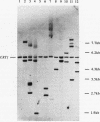Abstract
We have cloned and sequenced the CRY1 gene, encoding ribosomal protein S14 in Chlamydomonas reinhardtii, and found that it is highly similar to S14/rp59 proteins from other organisms, including mammals, Drosophila melanogaster, and Saccharomyces cerevisiae. We isolated a mutant strain resistant to the eukaryotic translational inhibitors cryptopleurine and emetine in which the resistance was due to a missense mutation (CRY1-1) in the CRY1 gene; resistance was dominant in heterozygous stable diploids. Cotransformation experiments using the CRY1-1 gene and the gene for nitrate reductase (NIT1) produced a low level of resistance to cryptopleurine and emetine. Resistance levels were increased when the CRY1-1 gene was placed under the control of a constitutive promoter from the ribulose bisphosphate carboxylase/oxygenase small subunit 2 (RBCS2) gene. We also found that the 5' untranslated region of the CRY1 gene was required for expression of the CRY1-1 transgene. Direct selection of emetine-resistant transformants was possible when transformed cells were first induced to differentiate into gametes by nitrogen starvation and then allowed to dedifferentiate back to vegetative cells before emetine selection was applied. With this transformation protocol, the RBCS2/CRY1-1 dominant selectable marker gene is a powerful tool for many molecular genetic applications in C. reinhardtii.
Full text
PDF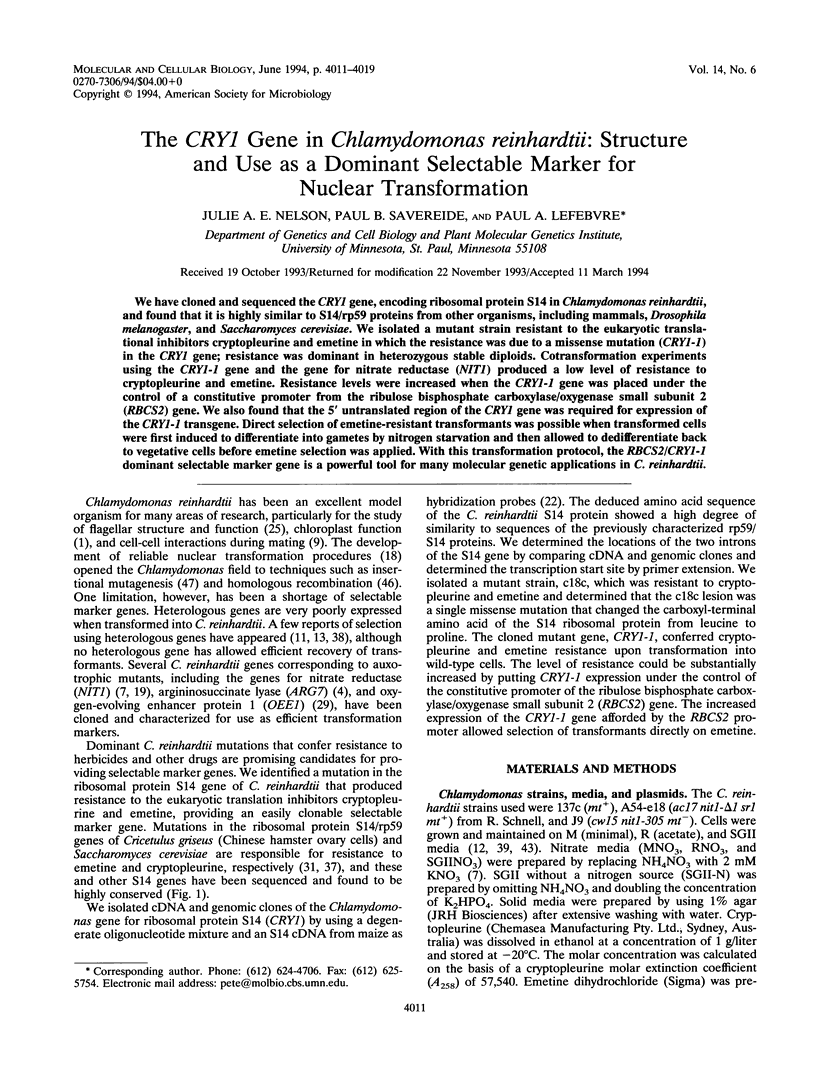
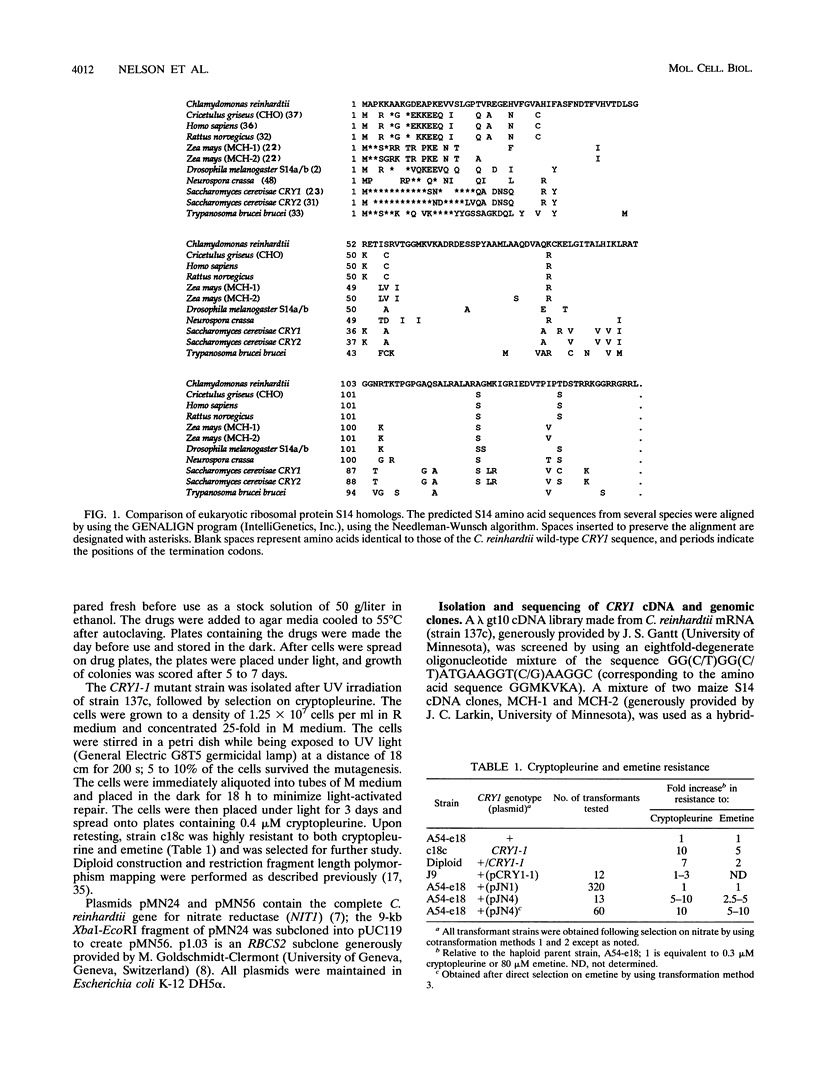
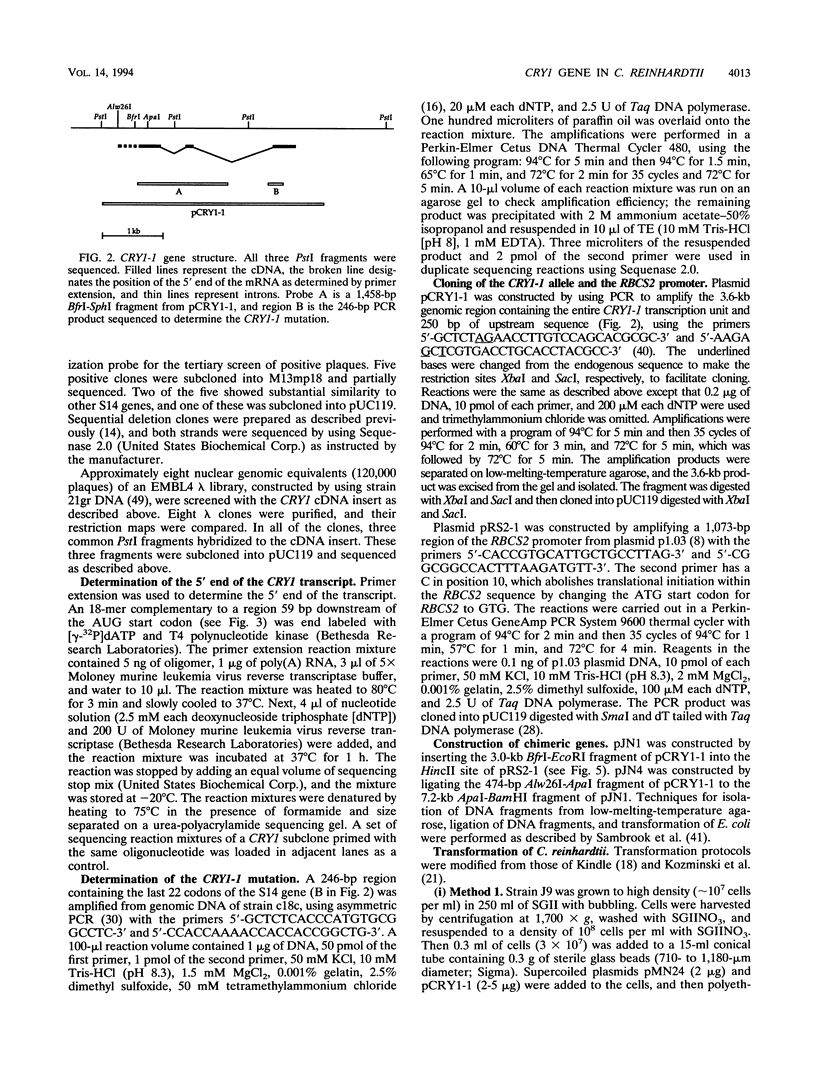
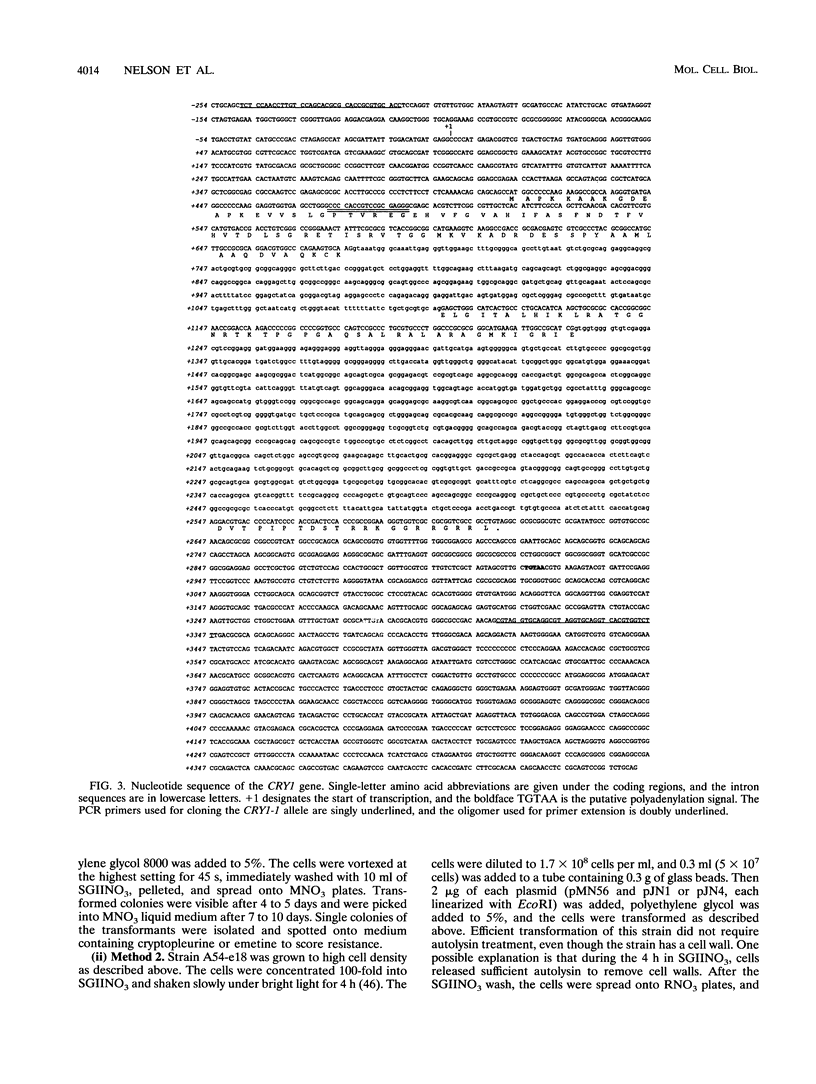
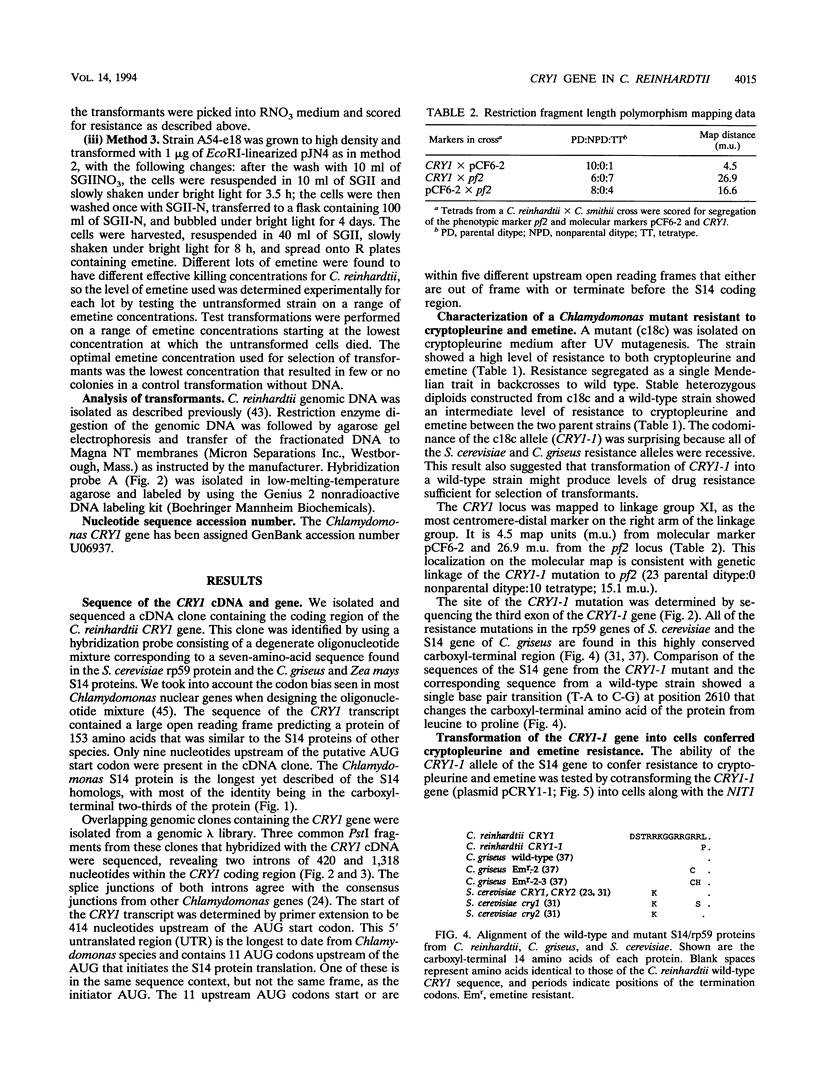
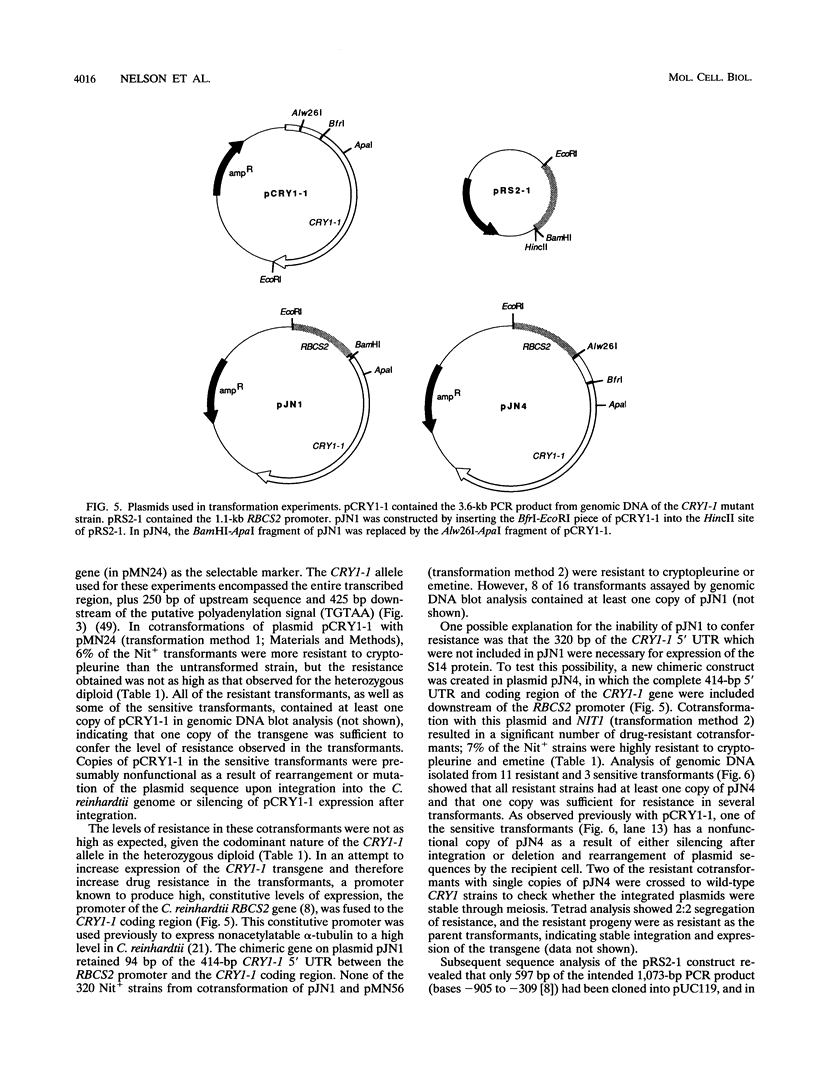
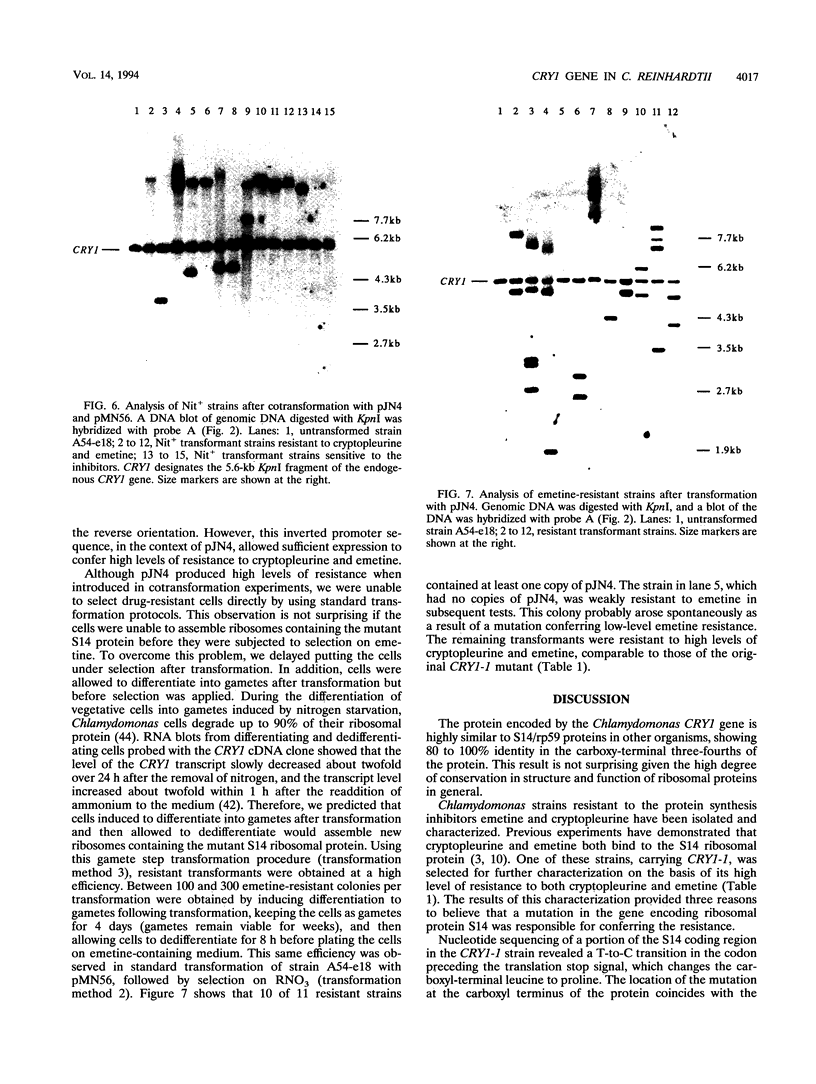
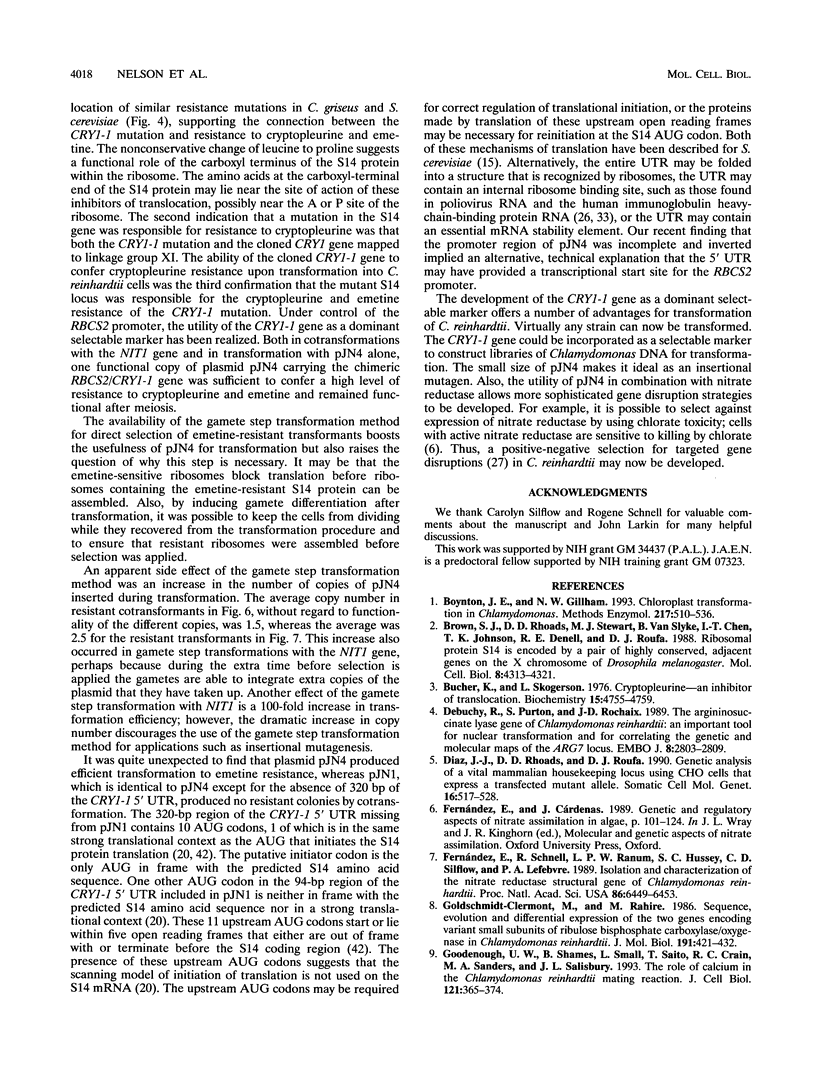
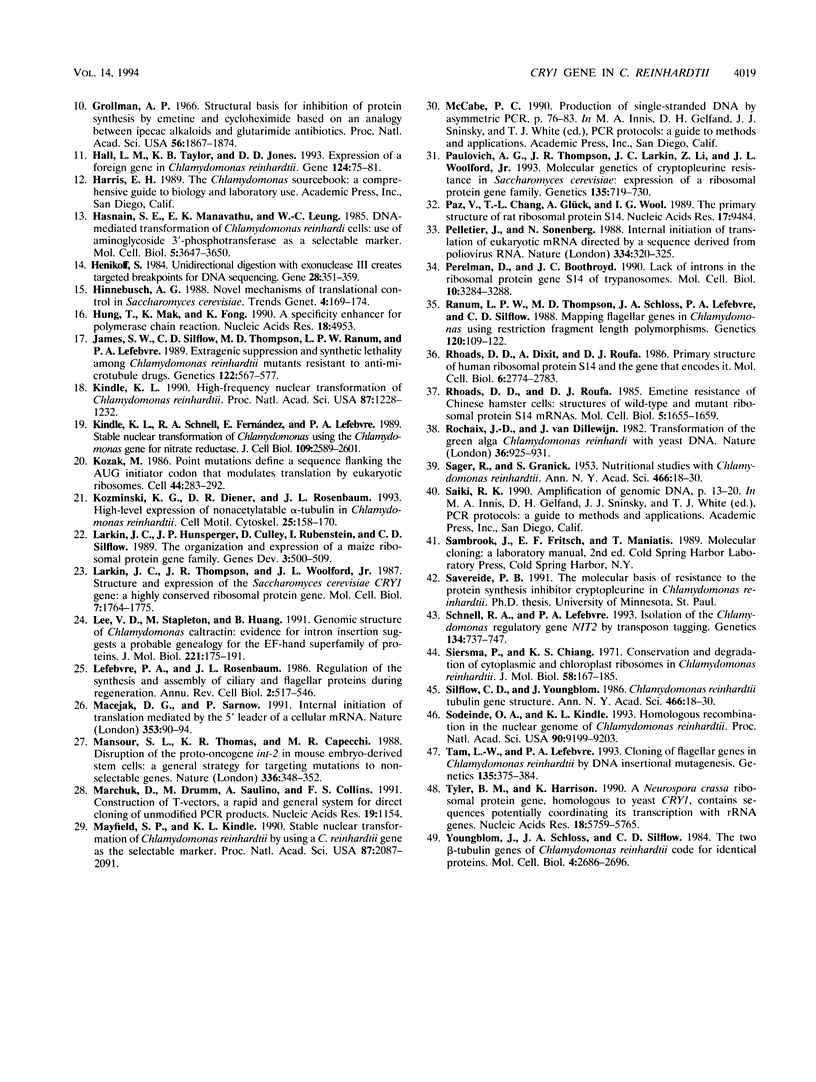
Images in this article
Selected References
These references are in PubMed. This may not be the complete list of references from this article.
- Boynton J. E., Gillham N. W. Chloroplast transformation in Chlamydomonas. Methods Enzymol. 1993;217:510–536. doi: 10.1016/0076-6879(93)17087-l. [DOI] [PubMed] [Google Scholar]
- Brown S. J., Rhoads D. D., Stewart M. J., Van Slyke B., Chen I. T., Johnson T. K., Denell R. E., Roufa D. J. Ribosomal protein S14 is encoded by a pair of highly conserved, adjacent genes on the X chromosome of Drosophila melanogaster. Mol Cell Biol. 1988 Oct;8(10):4314–4321. doi: 10.1128/mcb.8.10.4314. [DOI] [PMC free article] [PubMed] [Google Scholar]
- Bucher K., Skogerson L. Cryptopleurine--an inhibitor of translocation. Biochemistry. 1976 Nov 2;15(22):4755–4759. doi: 10.1021/bi00667a001. [DOI] [PubMed] [Google Scholar]
- Debuchy R., Purton S., Rochaix J. D. The argininosuccinate lyase gene of Chlamydomonas reinhardtii: an important tool for nuclear transformation and for correlating the genetic and molecular maps of the ARG7 locus. EMBO J. 1989 Oct;8(10):2803–2809. doi: 10.1002/j.1460-2075.1989.tb08426.x. [DOI] [PMC free article] [PubMed] [Google Scholar]
- Diaz J. J., Rhoads D. D., Roufa D. J. Genetic analysis of a vital mammalian housekeeping locus using CHO cells that express a transfected mutant allele. Somat Cell Mol Genet. 1990 Nov;16(6):517–528. doi: 10.1007/BF01233092. [DOI] [PubMed] [Google Scholar]
- Fernández E., Schnell R., Ranum L. P., Hussey S. C., Silflow C. D., Lefebvre P. A. Isolation and characterization of the nitrate reductase structural gene of Chlamydomonas reinhardtii. Proc Natl Acad Sci U S A. 1989 Sep;86(17):6449–6453. doi: 10.1073/pnas.86.17.6449. [DOI] [PMC free article] [PubMed] [Google Scholar]
- Goldschmidt-Clermont M., Rahire M. Sequence, evolution and differential expression of the two genes encoding variant small subunits of ribulose bisphosphate carboxylase/oxygenase in Chlamydomonas reinhardtii. J Mol Biol. 1986 Oct 5;191(3):421–432. doi: 10.1016/0022-2836(86)90137-3. [DOI] [PubMed] [Google Scholar]
- Goodenough U. W., Shames B., Small L., Saito T., Crain R. C., Sanders M. A., Salisbury J. L. The role of calcium in the Chlamydomonas reinhardtii mating reaction. J Cell Biol. 1993 Apr;121(2):365–374. doi: 10.1083/jcb.121.2.365. [DOI] [PMC free article] [PubMed] [Google Scholar]
- Grollman A. P. Structural basis for inhibition of protein synthesis by emetine and cycloheximide based on an analogy between ipecac alkaloids and glutarimide antibiotics. Proc Natl Acad Sci U S A. 1966 Dec;56(6):1867–1874. doi: 10.1073/pnas.56.6.1867. [DOI] [PMC free article] [PubMed] [Google Scholar]
- Hall L. M., Taylor K. B., Jones D. D. Expression of a foreign gene in Chlamydomonas reinhardtii. Gene. 1993 Feb 14;124(1):75–81. doi: 10.1016/0378-1119(93)90763-s. [DOI] [PubMed] [Google Scholar]
- Hasnain S. E., Manavathu E. K., Leung W. C. DNA-mediated transformation of Chlamydomonas reinhardi cells: use of aminoglycoside 3'-phosphotransferase as a selectable marker. Mol Cell Biol. 1985 Dec;5(12):3647–3650. doi: 10.1128/mcb.5.12.3647. [DOI] [PMC free article] [PubMed] [Google Scholar]
- Henikoff S. Unidirectional digestion with exonuclease III creates targeted breakpoints for DNA sequencing. Gene. 1984 Jun;28(3):351–359. doi: 10.1016/0378-1119(84)90153-7. [DOI] [PubMed] [Google Scholar]
- Hinnebusch A. G. Novel mechanisms of translational control in Saccharomyces cerevisiae. Trends Genet. 1988 Jun;4(6):169–174. doi: 10.1016/0168-9525(88)90023-6. [DOI] [PubMed] [Google Scholar]
- Hung T., Mak K., Fong K. A specificity enhancer for polymerase chain reaction. Nucleic Acids Res. 1990 Aug 25;18(16):4953–4953. doi: 10.1093/nar/18.16.4953. [DOI] [PMC free article] [PubMed] [Google Scholar]
- James S. W., Silflow C. D., Thompson M. D., Ranum L. P., Lefebvre P. A. Extragenic suppression and synthetic lethality among Chlamydomonas reinhardtii mutants resistant to anti-microtubule drugs. Genetics. 1989 Jul;122(3):567–577. doi: 10.1093/genetics/122.3.567. [DOI] [PMC free article] [PubMed] [Google Scholar]
- Kindle K. L. High-frequency nuclear transformation of Chlamydomonas reinhardtii. Proc Natl Acad Sci U S A. 1990 Feb;87(3):1228–1232. doi: 10.1073/pnas.87.3.1228. [DOI] [PMC free article] [PubMed] [Google Scholar]
- Kindle K. L., Schnell R. A., Fernández E., Lefebvre P. A. Stable nuclear transformation of Chlamydomonas using the Chlamydomonas gene for nitrate reductase. J Cell Biol. 1989 Dec;109(6 Pt 1):2589–2601. doi: 10.1083/jcb.109.6.2589. [DOI] [PMC free article] [PubMed] [Google Scholar]
- Kozak M. Point mutations define a sequence flanking the AUG initiator codon that modulates translation by eukaryotic ribosomes. Cell. 1986 Jan 31;44(2):283–292. doi: 10.1016/0092-8674(86)90762-2. [DOI] [PubMed] [Google Scholar]
- Kozminski K. G., Diener D. R., Rosenbaum J. L. High level expression of nonacetylatable alpha-tubulin in Chlamydomonas reinhardtii. Cell Motil Cytoskeleton. 1993;25(2):158–170. doi: 10.1002/cm.970250205. [DOI] [PubMed] [Google Scholar]
- Larkin J. C., Hunsperger J. P., Culley D., Rubenstein I., Silflow C. D. The organization and expression of a maize ribosomal protein gene family. Genes Dev. 1989 Apr;3(4):500–509. doi: 10.1101/gad.3.4.500. [DOI] [PubMed] [Google Scholar]
- Larkin J. C., Thompson J. R., Woolford J. L., Jr Structure and expression of the Saccharomyces cerevisiae CRY1 gene: a highly conserved ribosomal protein gene. Mol Cell Biol. 1987 May;7(5):1764–1775. doi: 10.1128/mcb.7.5.1764. [DOI] [PMC free article] [PubMed] [Google Scholar]
- Lee V. D., Stapleton M., Huang B. Genomic structure of Chlamydomonas caltractin. Evidence for intron insertion suggests a probable genealogy for the EF-hand superfamily of proteins. J Mol Biol. 1991 Sep 5;221(1):175–191. [PubMed] [Google Scholar]
- Lefebvre P. A., Rosenbaum J. L. Regulation of the synthesis and assembly of ciliary and flagellar proteins during regeneration. Annu Rev Cell Biol. 1986;2:517–546. doi: 10.1146/annurev.cb.02.110186.002505. [DOI] [PubMed] [Google Scholar]
- Macejak D. G., Sarnow P. Internal initiation of translation mediated by the 5' leader of a cellular mRNA. Nature. 1991 Sep 5;353(6339):90–94. doi: 10.1038/353090a0. [DOI] [PubMed] [Google Scholar]
- Mansour S. L., Thomas K. R., Capecchi M. R. Disruption of the proto-oncogene int-2 in mouse embryo-derived stem cells: a general strategy for targeting mutations to non-selectable genes. Nature. 1988 Nov 24;336(6197):348–352. doi: 10.1038/336348a0. [DOI] [PubMed] [Google Scholar]
- Marchuk D., Drumm M., Saulino A., Collins F. S. Construction of T-vectors, a rapid and general system for direct cloning of unmodified PCR products. Nucleic Acids Res. 1991 Mar 11;19(5):1154–1154. doi: 10.1093/nar/19.5.1154. [DOI] [PMC free article] [PubMed] [Google Scholar]
- Mayfield S. P., Kindle K. L. Stable nuclear transformation of Chlamydomonas reinhardtii by using a C. reinhardtii gene as the selectable marker. Proc Natl Acad Sci U S A. 1990 Mar;87(6):2087–2091. doi: 10.1073/pnas.87.6.2087. [DOI] [PMC free article] [PubMed] [Google Scholar]
- Paulovich A. G., Thompson J. R., Larkin J. C., Li Z., Woolford J. L., Jr Molecular genetics of cryptopleurine resistance in Saccharomyces cerevisiae: expression of a ribosomal protein gene family. Genetics. 1993 Nov;135(3):719–730. doi: 10.1093/genetics/135.3.719. [DOI] [PMC free article] [PubMed] [Google Scholar]
- Paz V., Chan Y. L., Glück A., Wool I. G. The primary structure of rat ribosomal protein S14. Nucleic Acids Res. 1989 Nov 25;17(22):9484–9484. doi: 10.1093/nar/17.22.9484. [DOI] [PMC free article] [PubMed] [Google Scholar]
- Pelletier J., Sonenberg N. Internal initiation of translation of eukaryotic mRNA directed by a sequence derived from poliovirus RNA. Nature. 1988 Jul 28;334(6180):320–325. doi: 10.1038/334320a0. [DOI] [PubMed] [Google Scholar]
- Perelman D., Boothroyd J. C. Lack of introns in the ribosomal protein gene S14 of trypanosomes. Mol Cell Biol. 1990 Jun;10(6):3284–3288. doi: 10.1128/mcb.10.6.3284. [DOI] [PMC free article] [PubMed] [Google Scholar]
- Ranum L. P., Thompson M. D., Schloss J. A., Lefebvre P. A., Silflow C. D. Mapping flagellar genes in Chlamydomonas using restriction fragment length polymorphisms. Genetics. 1988 Sep;120(1):109–122. doi: 10.1093/genetics/120.1.109. [DOI] [PMC free article] [PubMed] [Google Scholar]
- Rhoads D. D., Dixit A., Roufa D. J. Primary structure of human ribosomal protein S14 and the gene that encodes it. Mol Cell Biol. 1986 Aug;6(8):2774–2783. doi: 10.1128/mcb.6.8.2774. [DOI] [PMC free article] [PubMed] [Google Scholar]
- Rhoads D. D., Roufa D. J. Emetine resistance of Chinese hamster cells: structures of wild-type and mutant ribosomal protein S14 mRNAs. Mol Cell Biol. 1985 Jul;5(7):1655–1659. doi: 10.1128/mcb.5.7.1655. [DOI] [PMC free article] [PubMed] [Google Scholar]
- Schnell R. A., Lefebvre P. A. Isolation of the Chlamydomonas regulatory gene NIT2 by transposon tagging. Genetics. 1993 Jul;134(3):737–747. doi: 10.1093/genetics/134.3.737. [DOI] [PMC free article] [PubMed] [Google Scholar]
- Siersma P. W., Chiang K. S. Conservation and degradation of cytoplasmic and chloroplast ribosomes in Chlamydomonas reinhardtii. J Mol Biol. 1971 May 28;58(1):167–185. doi: 10.1016/0022-2836(71)90239-7. [DOI] [PubMed] [Google Scholar]
- Silflow C. D., Youngblom J. Chlamydomonas reinhardtii tubulin gene structure. Ann N Y Acad Sci. 1986;466:18–30. doi: 10.1111/j.1749-6632.1986.tb38381.x. [DOI] [PubMed] [Google Scholar]
- Sodeinde O. A., Kindle K. L. Homologous recombination in the nuclear genome of Chlamydomonas reinhardtii. Proc Natl Acad Sci U S A. 1993 Oct 1;90(19):9199–9203. doi: 10.1073/pnas.90.19.9199. [DOI] [PMC free article] [PubMed] [Google Scholar]
- Tam L. W., Lefebvre P. A. Cloning of flagellar genes in Chlamydomonas reinhardtii by DNA insertional mutagenesis. Genetics. 1993 Oct;135(2):375–384. doi: 10.1093/genetics/135.2.375. [DOI] [PMC free article] [PubMed] [Google Scholar]
- Tyler B. M., Harrison K. A Neurospora crassa ribosomal protein gene, homologous to yeast CRY1, contains sequences potentially coordinating its transcription with rRNA genes. Nucleic Acids Res. 1990 Oct 11;18(19):5759–5765. doi: 10.1093/nar/18.19.5759. [DOI] [PMC free article] [PubMed] [Google Scholar]
- Youngblom J., Schloss J. A., Silflow C. D. The two beta-tubulin genes of Chlamydomonas reinhardtii code for identical proteins. Mol Cell Biol. 1984 Dec;4(12):2686–2696. doi: 10.1128/mcb.4.12.2686. [DOI] [PMC free article] [PubMed] [Google Scholar]




